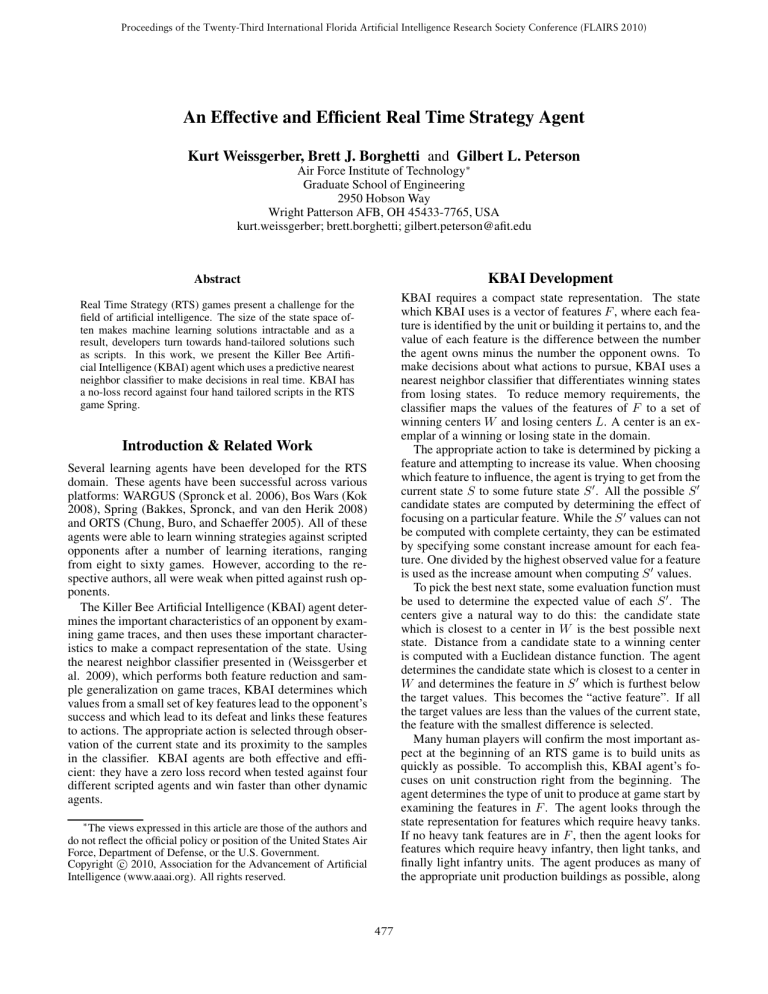
Proceedings of the Twenty-Third International Florida Artificial Intelligence Research Society Conference (FLAIRS 2010)
An Effective and Efficient Real Time Strategy Agent
Kurt Weissgerber, Brett J. Borghetti and Gilbert L. Peterson
Air Force Institute of Technology∗
Graduate School of Engineering
2950 Hobson Way
Wright Patterson AFB, OH 45433-7765, USA
kurt.weissgerber; brett.borghetti; gilbert.peterson@afit.edu
KBAI Development
Abstract
KBAI requires a compact state representation. The state
which KBAI uses is a vector of features F , where each feature is identified by the unit or building it pertains to, and the
value of each feature is the difference between the number
the agent owns minus the number the opponent owns. To
make decisions about what actions to pursue, KBAI uses a
nearest neighbor classifier that differentiates winning states
from losing states. To reduce memory requirements, the
classifier maps the values of the features of F to a set of
winning centers W and losing centers L. A center is an exemplar of a winning or losing state in the domain.
The appropriate action to take is determined by picking a
feature and attempting to increase its value. When choosing
which feature to influence, the agent is trying to get from the
current state S to some future state S . All the possible S candidate states are computed by determining the effect of
focusing on a particular feature. While the S values can not
be computed with complete certainty, they can be estimated
by specifying some constant increase amount for each feature. One divided by the highest observed value for a feature
is used as the increase amount when computing S values.
To pick the best next state, some evaluation function must
be used to determine the expected value of each S . The
centers give a natural way to do this: the candidate state
which is closest to a center in W is the best possible next
state. Distance from a candidate state to a winning center
is computed with a Euclidean distance function. The agent
determines the candidate state which is closest to a center in
W and determines the feature in S which is furthest below
the target values. This becomes the “active feature”. If all
the target values are less than the values of the current state,
the feature with the smallest difference is selected.
Many human players will confirm the most important aspect at the beginning of an RTS game is to build units as
quickly as possible. To accomplish this, KBAI agent’s focuses on unit construction right from the beginning. The
agent determines the type of unit to produce at game start by
examining the features in F . The agent looks through the
state representation for features which require heavy tanks.
If no heavy tank features are in F , then the agent looks for
features which require heavy infantry, then light tanks, and
finally light infantry units. The agent produces as many of
the appropriate unit production buildings as possible, along
Real Time Strategy (RTS) games present a challenge for the
field of artificial intelligence. The size of the state space often makes machine learning solutions intractable and as a
result, developers turn towards hand-tailored solutions such
as scripts. In this work, we present the Killer Bee Artificial Intelligence (KBAI) agent which uses a predictive nearest
neighbor classifier to make decisions in real time. KBAI has
a no-loss record against four hand tailored scripts in the RTS
game Spring.
Introduction & Related Work
Several learning agents have been developed for the RTS
domain. These agents have been successful across various
platforms: WARGUS (Spronck et al. 2006), Bos Wars (Kok
2008), Spring (Bakkes, Spronck, and van den Herik 2008)
and ORTS (Chung, Buro, and Schaeffer 2005). All of these
agents were able to learn winning strategies against scripted
opponents after a number of learning iterations, ranging
from eight to sixty games. However, according to the respective authors, all were weak when pitted against rush opponents.
The Killer Bee Artificial Intelligence (KBAI) agent determines the important characteristics of an opponent by examining game traces, and then uses these important characteristics to make a compact representation of the state. Using
the nearest neighbor classifier presented in (Weissgerber et
al. 2009), which performs both feature reduction and sample generalization on game traces, KBAI determines which
values from a small set of key features lead to the opponent’s
success and which lead to its defeat and links these features
to actions. The appropriate action is selected through observation of the current state and its proximity to the samples
in the classifier. KBAI agents are both effective and efficient: they have a zero loss record when tested against four
different scripted agents and win faster than other dynamic
agents.
∗
The views expressed in this article are those of the authors and
do not reflect the official policy or position of the United States Air
Force, Department of Defense, or the U.S. Government.
c 2010, Association for the Advancement of Artificial
Copyright Intelligence (www.aaai.org). All rights reserved.
477
with required infrastructure. Any production buildings completed produce the chosen production unit.
When enough units have been produced, the agent selects
a target. KBAI agents attack the opponent’s “centers of gravity”: the units/buildings which have a large impact on the
opposing strategy being pursued. There are two different
targeting scenarios faced by KBAI agent’s: when some of
the opponent’s units can be seen and when they cannot. In
the former case, a target is selected from the units which are
visible. Offensive units are targeted first, then buildings. In
the latter case KBAI uses perfect information to get a list of
all of the enemy’s units. This list is searched for strategic
targets. Strategic targets are based on the active feature: if
the active feature is an infantry unit, the strategic target is
infantry unit production buildings. If the active feature is
metal production, then the strategic target is metal production buildings. The closest strategic target is computed by
determining the center of mass (average of the Euclidean locations) for all of the available offensive units.
many units as it can as fast as possible. As discussed earlier,
this is generally the determining factor of an RTS game.
Table 1: Dynamic agent win rate against the scripted agents.
Agent
KBAI
DRA
KAI
RAI
Blitz
100%
74%
36%
8%
Infantry Rush
100%
90%
18%
66%
Tank Rush
100%
68%
30%
14%
Turtle
100%
70%
38%
20%
If an agent is effective, then we examine whether it is efficient. An effective agent is one which wins at least 60% of
its games. Table 2 has the mean game length for the effective dynamic agents, calculated only from games which the
dynamic agent won. KBAI has a lower mean game length
against all opponents, and two-sample t-tests for a difference
between the game lengths of KBAI and DRA give significant evidence of a difference.
Experiment
Our goal is to build an agent which is effective and efficient
against many different opponents. The effectiveness of an
agent is its win percentage. Efficiency is an agent’s time-towin. An effective, efficient agent is one which wins fast.
KBAI is tested in the RTS game Spring, an open source
RTS platform. Each participant in a Spring game starts with
a Commander unit. Games end when one participants Commander is destroyed. To validate the effectiveness and efficiency of the dynamic agent KBAI, its performance is compared to that of a dynamic random agent (DRA) and two full
featured agents developed for the Spring domain, RAI and
KAI (available with the Spring distribution). Each agent is
tested against four scripted agents in a fifty game match.
KBAI agents are only allowed to produce the units which
are present in the scripted opponents: medium/light tanks
and heavy/light infantry units. It builds in random locations and has no algorithm to keep the commander protected.
KBAI generates a different nearest neighbor classifier for
each script from twenty-four game traces, subject to the constraints |F | ≤ 6, |W | ≤ 6 and |L| ≤ 6. Forty five different
features are available. All centers were vectors of real values on the interval [−1, 1]. DRA is an agent which uses the
same underlying architecture as KBAI, but makes a random
choice whenever KBAI would reason on the current state.
Four different scripted agents were developed for use as
opponents. The infantry rush and tank rush quickly produce and attack with cheap units. The blitz creates an unstoppable army to overwhelm the opponent. Turtle builds a
“shell” of defensive buildings and waits for the opponent to
attack, responding with a large counteroffensive.
Table 2: Mean time to win (seconds) for effective dynamic
agents.
Agent
KBAI
DRA
Blitz
507
604
IR
540
750
TR
512
724
Turtle
548
905
KBAI outperforms the other test agents, in terms of both
effectiveness and efficiency. It is a robust system which can
be used to defeat different types of scripted agent, without
the weakness to rush strategies of other reinforcement learning approaches.
Future areas of interest include expanding the action
space for economic decisions: currently KBAI can only produce four different attack unit and six building types. We
hope to increase this number and show the continued viability of our method, as well as seek ways to combat more
dynamic agents.
References
Bakkes, S.; Spronck, P.; and van den Herik, J. 2008. Rapid
adaptation of video game ai. In 9th International Conference
on Intelligent Games and Simulation GAME-ON.
Chung, M.; Buro, M.; and Schaeffer, J. 2005. Monte carlo
planning in rts games. In IEEE Symposium on Computational Intelligence and Games.
Kok, E. 2008. Adaptive reinforcement learning agents in
rts games. Master’s thesis, University Utrecht, The Netherlands.
Spronck, P.; Ponsen, M.; Sprinkhuizen-Kuyper, I.; and
Postma, E. 2006. Adaptive game ai with dynamic scripting. Machine Learning Volume 63:pp 217–248.
Weissgerber, K.; Borghetti, B.; Lamont, G.; and Mendenhall, M. 2009. Towards automated feature selection in realtime strategy games. In GAME-ON North America, 25–32.
Results, Analysis & Future Work
Table 1 shows the winning percentage for all agents versus the scripted agents. KBAI clearly outperforms all other
dynamic agents, winning 100% of the time against all the
scripted agents. The only other effective dynamic agent is
DRA, which uses the same framework as KBAI: it builds as
478





